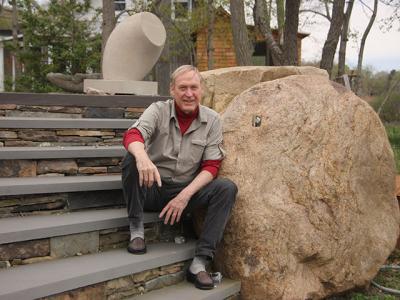Halsted Welles: Gardens, Music, and the Seasons

Halsted Welles is a garden builder. He is not a landscaper or a lawn care specialist. His particular skill set, which includes expertise in horticulture, construction, masonry, bricklaying, as well as an Ivy League education in art history and sculpting, has led him to his nearly 50-year career as the founder of Halsted Welles Associates, a New York City design-and-build firm that specializes in creating lush outdoor living spaces out of urban terraces and rooftops.
It will also be leading him to Carnegie Hall next Thursday when his artwork — a series of time-lapse images of the gardens he’s created as they undergo the vicissitudes of weather and city life — will accompany the performance of a piano concerto titled “Four Seasons” by Georgia Shreve.
Mr. Welles is a part-time Sag Harbor resident who is in the process of creating an “earthwork” at his Noyac Road properties by transforming his backyards and a neighbor’s into a park. He said that straddling the worlds of art and horticulture has been a lifelong pursuit ever since his father, a screenwriter, and his mother, a costume designer, first introduced him to the joys of environmental design during his childhood when they began adding plants and bushes to the grounds of a house they were building in Nyack, N.Y. “Since I came from an arty background and education, it seemed natural to figure out the connection between art and gardens,” he said. “Somehow there was a welding to be done, I didn’t know exactly what it was, but that was my adventure.”
During his years at Antioch College he was given the opportunity to do a work-study stint at the Brooklyn Museum Art School, where he took a course in sculpture. He later spent nine months apprenticing with a sculptor in Paris. “I was sitting in the midst of a bunch of neo-Dadaists — one painter was shooting a .22 filled with paint capsules,” he recalled. A graduate degree in art from Yale followed, and then “I moved to New York and put up the shingle: sculptor.”
“I had a couple of shows that went nowhere, not even a sketch sold,” he recalled. “And if you wrestle some big rocks up an elevator into a little gallery, it isn’t a happy experience. I wasn’t a horrible sculptor, there just wasn’t a need for them. So I set out to create a need for sculptures. That’s how I got into building gardens.”
After landing a job at a garden store by touting his credentials as a mason — “I can build patios,” he boasted — he started developing a client base and soon lit out on his own.
Mr. Welles met Ms. Shreve, a composer and writer, when she became a client of his. He helped turn the terrace of her apartment into an urban oasis complete with a spacious pergola, a dining area that seats 12, and a floor covered in pink granite.
It was Mr. Welles who approached Ms. Shreve about collaborating on a project that would end up becoming part of a Carnegie Hall performance featuring both of their works. Inspired by the concept of using digital technology to create a real-time portrait of a garden, Mr. Welles decided to set up several GoPro cameras around some of the spaces he’d designed for clients. After seeing the shots of spring and summer captured by the cameras, he had an intuition that something magical would happen if the time-lapse images were set to music. “I thought, ‘This is kind of cool. Why don’t I show Georgia and maybe she’ll write a piece,’ ” he said. He invited her to his studio, where he had 11 monitors set up to display the images and Ms. Shreve immediately asked, “Could you do all four seasons?” recalled Mr. Welles. “And I said, ‘Well, yeah, sure what the hell.’ ”
Turns out, Ms. Shreve had already composed a piece titled “Four Seasons,” and she thought the images would complement it perfectly. “You can’t tell if the music is generating the change in seasons or vice versa,” said Ms. Shreve of how well the works fit together.
With Ms. Shreve’s directive to capture gardens in the fall and winter, Mr. Welles chose his subjects carefully. “For fall, I picked a building in SoHo with a grove of Japanese maple trees on a rooftop because I knew I’d get some color in there somehow,” he said. “And I used this terrace that overlooks Central Park for winter.”
While gathering the images for his work, Mr. Welles said he found himself surprised by three main discoveries. First, “there’s an honesty to the time-lapse medium,” he said. “Either the bird landed on the branch or it didn’t.” Second, although the focus of the work was meant to be the plant life in the garden, it often got upstaged. “The goddamn shadow patterns crossing the brick walls were so cool,” he said. And third, “When the hell would you ever think that a window would be a major part of a garden?” he said. “It’s major, major. There’s a whole story just looking at the window because it’s reflecting everything — clouds, blue skies, lights.”
Unlike Vivaldi’s “Four Seasons,” which begins with spring, Ms. Shreve decided the images should start with summer and end on the optimistic note of spring. The season of rebirth, as it happens, is an apt metaphor for Mr. Welles’s art project. “The piece will have an afterlife,” he said. Mr. Welles recently added a gallery to his office building in Brooklyn, and he has grand plans to showcase his work in that space. “I’m building a screen that’s 10 feet high and 20-some-odd feet long and I’m going to project it onto that,” he said.
